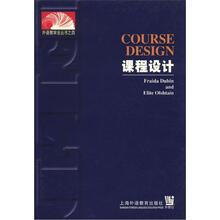外语教学法丛书(4):课程设计

目 录内容简介
Thanks
Introduction
1 The fact-finding stage: assessing societal factors
Overview
1.1 The language setting
1.1.1 The continuum: ESL- EFL
1.2 Patterns oflanguage use in society
1.2.1 Education
1.2.2 The labor market
1.2.3 The process of modernization
1.3 Group and individual attitudes toward language
1.4 The political and national context
Practical applications
References
2 The basis for curriculum and syllabus designing
Overview
2.1 Establishing realistic goals
2.1.1 In an EFL setting
2.1.2 In an ESL setting
2.1.3 Planning for courses outside the school system
2.1.4 Language analysis or language use as course goals
2.2 Surveying existing programs
2.2.1 The existing syllabus
2.2.2 The materials in use
2.2.3 Theteachers
2.2.4 Thelearners
2.2.5 Theresources
2.3 When the materials in use constitute the curriculum and syllabus
2.4 The separate purposes of a curriculum and a syllabus
2.4.1 The components of a curriculum
2.4.2 Types of syllabuses
Practical applications
References
3 How goals become realized through instructional plans
Overview
3.1 Translating general goals into syllabus objectives
3.1.1 A curriculum provides a statement of policy
3.1.2 The link between goals and objectives
3.1.3 Syllabuses without a curriculum
3.2 Language content, process, and product in syllabus designs
3.2.1 The language content dimension
3.2.2 The process dimension
3.2.3 The product dimension
3.3 Selecting the shape of the syllabus
3.3.1 The linear format
3.3.2 The modular format
3.3.3 The cyclical format
3.3.4 The matrix format
3.3.5 The story-line format
3.4 The place of method
Practical applications
References
4 A curriculum developed on communicative goals Overview
4.1 Sociocultural views of the nature of language
4.2 A cognitively-based view oflanguage learning
4.2.1 Strategies and tactics
4.2.2 Context-embedded and context-reducedlanguage use
4.2.3 The holistic approach to language learning
4.2.4 What learners' errors tell us
4.3 The fundamentals of a humanistic curriculum
4.4 Exploring the roles of teachers, learners and others within a communicative curriculum
4.4.1 Teaching/learning as a metaphor
4.4.2 Is teaching/learning adequate>
4.4.3 Cross-culruralimplications
4.4.4 Developing alternative metaphors
Practical applications
References
5 The scope of a communicative syllabus
Overview
5.1 Expansion of the language content dimension
5.1.1 Conceptual and functional meaning
5.1.2 Socioculturalappropriateness
5.1.3 Longer spans of discourse
……
6 Focuslng onlanguage contentin a communicative syllabus
7 Focuslng on process: materials that dealwith sociocultural appropriareness
8 Focusina on product: materials that deal with the reading skill
9 Creating materials: the link between syllabus and audience
Epilogue
Cumulative bibliography
Acknowledgements
Index
Introduction
1 The fact-finding stage: assessing societal factors
Overview
1.1 The language setting
1.1.1 The continuum: ESL- EFL
1.2 Patterns oflanguage use in society
1.2.1 Education
1.2.2 The labor market
1.2.3 The process of modernization
1.3 Group and individual attitudes toward language
1.4 The political and national context
Practical applications
References
2 The basis for curriculum and syllabus designing
Overview
2.1 Establishing realistic goals
2.1.1 In an EFL setting
2.1.2 In an ESL setting
2.1.3 Planning for courses outside the school system
2.1.4 Language analysis or language use as course goals
2.2 Surveying existing programs
2.2.1 The existing syllabus
2.2.2 The materials in use
2.2.3 Theteachers
2.2.4 Thelearners
2.2.5 Theresources
2.3 When the materials in use constitute the curriculum and syllabus
2.4 The separate purposes of a curriculum and a syllabus
2.4.1 The components of a curriculum
2.4.2 Types of syllabuses
Practical applications
References
3 How goals become realized through instructional plans
Overview
3.1 Translating general goals into syllabus objectives
3.1.1 A curriculum provides a statement of policy
3.1.2 The link between goals and objectives
3.1.3 Syllabuses without a curriculum
3.2 Language content, process, and product in syllabus designs
3.2.1 The language content dimension
3.2.2 The process dimension
3.2.3 The product dimension
3.3 Selecting the shape of the syllabus
3.3.1 The linear format
3.3.2 The modular format
3.3.3 The cyclical format
3.3.4 The matrix format
3.3.5 The story-line format
3.4 The place of method
Practical applications
References
4 A curriculum developed on communicative goals Overview
4.1 Sociocultural views of the nature of language
4.2 A cognitively-based view oflanguage learning
4.2.1 Strategies and tactics
4.2.2 Context-embedded and context-reducedlanguage use
4.2.3 The holistic approach to language learning
4.2.4 What learners' errors tell us
4.3 The fundamentals of a humanistic curriculum
4.4 Exploring the roles of teachers, learners and others within a communicative curriculum
4.4.1 Teaching/learning as a metaphor
4.4.2 Is teaching/learning adequate>
4.4.3 Cross-culruralimplications
4.4.4 Developing alternative metaphors
Practical applications
References
5 The scope of a communicative syllabus
Overview
5.1 Expansion of the language content dimension
5.1.1 Conceptual and functional meaning
5.1.2 Socioculturalappropriateness
5.1.3 Longer spans of discourse
……
6 Focuslng onlanguage contentin a communicative syllabus
7 Focuslng on process: materials that dealwith sociocultural appropriareness
8 Focusina on product: materials that deal with the reading skill
9 Creating materials: the link between syllabus and audience
Epilogue
Cumulative bibliography
Acknowledgements
Index
目 录内容简介
《外语教学法丛书(4):课程设计》共十二章,涉及教与学的关系、教学安排、课堂活动、语言技能等等方面,绝大部分章节都是先介绍该章内容,然后列出各种具体教学活动(tasks),其后是对各项活动的分析评述。例如第六章“说的技能”共有四小节,即1)为什么要说;2)交际性活动;3)语言交际与流利;4)演戏和角色扮演,每节都提供各种相应的具体活动和作者对各项活动的评述。教师可以根据自己的实际情况选择其中某些活动进行课堂教学。
比价列表
公众号、微信群
 缺书网
缺书网微信公众号
 扫码进群
扫码进群实时获取购书优惠




